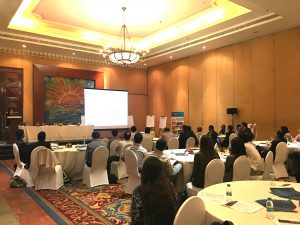In April 2016, M4D Utilities co-located the annual Asia Working Group with Sankalp in Mumbai, convening 60 stakeholders to share best practices, hear about the latest mobile-enabled innovations for utilities and network. Conversations were diverse and included panel discussions focused on machine-to-machine technology, mobile money and innovation.
The final session of the day – Jumpstart – moderated by Max Cuvellier, M4D Ecosystem Accelerator Head and spotlighted here, gave grantees of the M4D Utilities Innovation Fund a chance to pitch to investors, honing their skills for this tough yet essential activity for start-ups.
In this blog, two of our moderators share insights from their panels:
Machine-to-machine (M2M) technology
Lori Gonnu, telecom advisor to 1001fontaines
How can M2M technology support the services needed to reach the 663 million people who do not have access to clean drinking water, the 2.4 billion who lack sanitation facilities and the one in five who do not enjoy reliable modern electricity?
The panel session “Machine to Machine Connectivity Use Cases” demonstrated that social entrepreneurs and mobile operators are developing a wealth of diverse innovative solutions incorporating M2M to respond to these challenges.
India’s first electronic public toilet developed by Eram Scientific presented the eToilet, which is embedded with sensors and GSM communications to monitor usage, cleanliness, water levels and other parameters – with the aim of delivering improved public sanitation facilities in India. Monitoring of rural technical equipment is also essential for Village Infrastructure Angels, a grantee of the M4D Utilities Innovation Fund providing solar powered agricultural equipment in Vanuatu. M2M capabilities help the organisation to monitor energy outputs in order to optimise services for more affordable energy.
From the mobile operator side, Dialog Sri Lanka and Vodafone India also emphasised the essential role of M2M in improving the cost efficiency of energy and other utility services thanks to remote real-time metering, monitoring, control, payment and access to data capabilities.
The innovative M2M solutions share commonalities in the technical application and the business rationale. They address the same end users based on remotely monitored and actionable services which improve reliability and efficiency for more affordable services, and a simple way to pay for them. The M2M models combat the challenges of last-mile distribution, maintenance and timely payment. They provide real-time reliable data on service use and customer consumption, supporting business management, impact evaluation and reporting to investors.
Leveraging the technical and business commonalities through a shared platform would generate economies of scope and scale, thereby contributing to increasing accessibility and affordability for the end-users to all of the services whilst enabling social entrepreneurs to scale and accelerate their development to reach their social and business objectives.
Mobile technology and the mobile industry are ideally positioned to support social entrepreneurs in the creation of « Connected Villages » with access to all of the utilities, and to share in the value from the new services and from the improvement of socio-economic conditions in un(der)-served areas.
Mobile payments
Hege Aschim, Commercial Analyst, Mobile Money, GSMA
This session explored the synergies between mobile payments and utility services highlighting how these types of services can benefit from each other. The panel included stakeholders from both sides, with Idea Cellular (India) and eSewa (Nepal) representing mobile payments, and Samagra, a sanitation service in India, along with Brighterlite, a provider of solar home power systems in Myanmar and Pakistan, representing the service providers.
The mobile money landscape in Asia is unique compared to Sub-Saharan Africa, with OTC (over-the-counter) transactions dominating the mobile payment space, and strict enabling regulations. India’s market is opening up to the mobile money opportunity with the Government giving 11 in-principle payment licences earlier this year. Aditya Birla Nuvo, the parent company of Idea Cellular is one of the recipients of the license and suggested that although OTC will continue in the short-term, the nature of mobile money transactions will change over time, as the youth adopt mobile money and agents increasingly gain the trust of customers.
Utility payments are an important use case for both Idea Cellular and ESewa, as the average family in Asia makes four utility payments each month. In Nepal, using mobile to pay bills instead of travelling long distances to reach banks is an important service for customers living in remote areas.
Samagra shared how they are using their toilet facilities to create community centers in urban slums, by offering a place where users can also use financial services. They are effectively educating low-income people in using digital financial services on behalf of payment providers.
Brighterlite shared their experiences of working with mobile payment providers in Myanmar and Pakistan. In Pakistan, EasyPaisa has a large distribution network that Brighterlite leverages both for distribution of solar homes systems, and collecting payments. In Myanmar, mobile money is yet to scale-up and has less reach than in Pakistan but some organisations are now starting to build out their mobile payment services.
There are clear synergies between utility services and mobile payments, beyond mutually accessing unbanked or underbanked customers. Utility bills need to be paid in regular installments, thus providing more transactions for mobile payment providers. The regularity of the payments also has an education element that could spill over and customers might try additional transaction types. For utility services, mobile payments have a wide reach in many markets in Asia, and reduce the cost of cash, which is important when addressing low-income individuals.
Demonstrating how these mobile technologies (M2M & Mobile Money) are being implemented in real-life examples was an important part of the Working Group and we were lucky enough to have innovators demo their mobile-enabled products already enhancing access to water, sanitation and energy. We’ll be sharing these innovative examples in our next blog.


